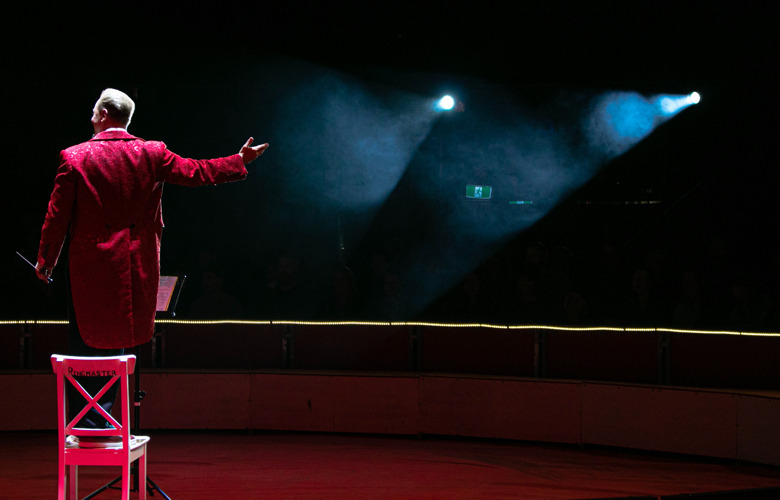
The Greatest Showman celebrates the birth of great circus extravaganzas and tells of a visionary who rose from nothing to create a spectacle that became a worldwide sensation. Portraying P. T. Barnum in the movie was Hugh Jackman’s dream project since 2009. His dream finally came true in 2017, when The Greatest Showman premiered in movie theaters around the world. Since August 2020, the inspiring, life-affirming, and heart-warming musical is now available for us on Disney+ to continue on dreaming.
The Greatest Showman hit all the right tones, as it propelled me from sadness, to happiness, to feeling like I could take on the entire world.
I quickly forgave its Hollywood kitschiness. While it was surely far too black and white to be true to real life, the movie delivered a wonderful feel-good message: Follow your dreams and accept what makes you different.
In many ways, the musical does exactly what it claims Barnum did throughout his career: it celebrates humanity, entertains, and leaves people’s eyes sparkling with joy.
Yet, knowing that the characterization of the main character as a great philanthropist is far too good to be true, I began to wonder…
Who was the real P. T. Barnum?
For all of you who are wondering the same thing, here is a selection of 10 interesting historical facts, giving a glimpse into the real Barnum’s life.
As the LA Times points out, Barnum could have easily been a villainous figure rather than a hero of the film, as he not only conned people throughout his career but he exploited marginalized groups and played upon his audience’s racist prejudices of the time to draw crowds.
The Greatest Showman lightly touches on some of these issues. But, because the movie is meant to be an inspiring and uplifting musical, it mostly glosses over Barnum’s dark past.
The Greatest Showman portrays Barnum as a hero and ally of people whom society had left behind. Unfortunately, this was not the case.
For example, Barnum’s first “curiosity” is not a character in the new film. Joice Heth was an elderly slave who Barnum actually purchased. He passed her off as the 160-year-old nurse to George Washington. When she died, at about half that age, Barnum sold tickets to her public autopsy in order to “prove” her advanced age.
One could argue that Barnum’s profiting from putting people with abnormalities and disabilities on public display was exploitation.
And, even though Barnum possessed anti-slavery convictions, both his actions as a showman and his “freak shows” themselves can at times certainly be considered as racist and discriminatory.
No. Charles Sherwood Stratton, who went by the stage name General Tom Thumb, was recruited by P. T. Barnum when he was only 4 years old, not 22 like in the movie. In real life, Stratton and Barnum were even distant cousins.
As seen to some degree in the film, Stratton’s performances helped to change the public’s perception of freak shows, which had up until then been considered as unpleasant and scandalous.
The Bearded Lady actually began her career as The Infant Esau at the age of one!
Barnum had not been laid off from a desk job.
Instead, Barnum owned a general store. The statewide lottery network had been his main source of income. After lotteries were banned in Connecticut, P. T. Barnum had to sell his store.
He moved to New York City.
Here sources differ. Some say Barnum published his own newspaper. This resulted in him being arrested for publishing libel. After he was released from prison, Barnum coerced a businessman to offer him credit right after Barnum had exposed a different company’s stock-issuing scheme.
Other sources state that once arrived in New York, Barnum began working as a showman, starting a variety troupe. In 1836, his variety troupe, Barnum’s Grand Scientific and Musical Theater, had a year of mixed success.
Then came the U. S. financial crisis known as the Panic of 1837, which led to three years of hard times for Barnum.
He found success again after purchasing and reinventing Scudder’s American Museum, which he renamed Barnum’s American Museum.
At no point did Barnum use sunken ships as collateral.
The multicultural romance between Barnum’s partner and the trapeze artist Anne Wheeler was one of the parts of the movie I loved the most. However, neither character ever existed. Both are completely made up creations of the film. Neither is even based on real persons.
This is likely true. Many in the public had long considered theaters dens of sin, and the oddities and performances on display in Barnum’s museum fueled their outrage.
Over the years, Barnum tried to change that perception, but when his American Museum burned down in 1865, there were those who mourned its passing and still those who celebrated that it was gone.
Yes. Barnum’s American Museum burned to the ground in a fire on July 13, 1865. The origin of the fire was never discovered. However, his addition of pro-Unionist lectures, exhibits, and dramas incited a Confederate arsonist to start a fire there the year prior.
If the 1865 fire was arson, it’s likely it was provoked by Barnum’s Unionist sympathies, not due to outrage over the sideshows at his museum.
After the fire, Barnum quickly reopened the American Museum at another location, but that too burned down in 1868, leading him to enter the circus business.
P. T. Barnum started his circus quite late in life. He was already 60 years old. Not still a young man, like in the movie.
Five years after his first museum burned down, in 1870, he partnered with circus owners William Cameron Coup and Dan Castello to start P. T. Barnum’s Grand Traveling Museum, Menagerie, Caravan, and Hippodrome.
This eventually came to be known as the “greatest traveling show on earth.” Barnum took full control of the circus in 1875.
His most well-known partnership came six years later when he teamed up with James A. Bailey and James L. Hutchinson, securing acts like Jumbo, the six-and-a-half ton elephant.
In 1887, the circus was rebranded with the more familiar name Barnum and Bailey Brothers Greatest Show on Earth.
Barnum died in 1891.
No. Barnum never had a romance with Swedish opera singer Jenny Lind. The picture of them kissing in the newspaper never existed.
In his autobiographies, Barnum conveys deep love for Charity, writing that on the day he married her, he “became the husband of one of the best women in the world.” She was his bedrock throughout the marriage until her death in 1873.
They were married for 44 years.
After her death, Barnum married Nancy Fish, who he remained with until his death in 1891.
It seems, she quit because Lind was uncomfortable with Barnum’s relentless marketing of her. After 93 concerts, they broke ties and she completed the tour under new management.
No matter how far the movie The Greatest Showman might stray from reality, P. T. Barnum undoubtedly was a visionary who ushered in a new era of big circus shows.
He did bring magic to the masses and left us a powerful circus empire.
Actor Hugh Jackman even goes so far as to say, “Barnum’s drive and endeavors led to the birth of modern day America. The idea that you could be who you want to be, that it doesn’t matter where you’re born or what school you went to. And Barnum used a lot of imagination and a hell of a lot of will and mongrel spirit.”
Unfortunately, even legends have to come to an end. The dwindling attendance and high operating costs of their circus forced the Ringling Bros. and Barnum & Bailey Circus to close on May 21, 2017 – after 146 years of uninterrupted operation.
The circus shut down just seven months prior to the movie’s release.
Don’t Wear That Hat: Theatre Superstitions & their Origins
Entertainment with A Splash: A History of Aquatic Shows


Liam Klenk was born in Central Europe and has since lived on four continents. Liam has always been engaged in creative pursuits, ranging from photography and graphic design, to writing short stories and poetry, to working in theatre and shows. In 2016, Liam published his first book and memoir, 'Paralian'.
Read Full Profile© 2021 TheatreArtLife. All rights reserved.

Thank you so much for reading, but you have now reached your free article limit for this month.
Our contributors are currently writing more articles for you to enjoy.
To keep reading, all you have to do is become a subscriber and then you can read unlimited articles anytime.
Your investment will help us continue to ignite connections across the globe in live entertainment and build this community for industry professionals.